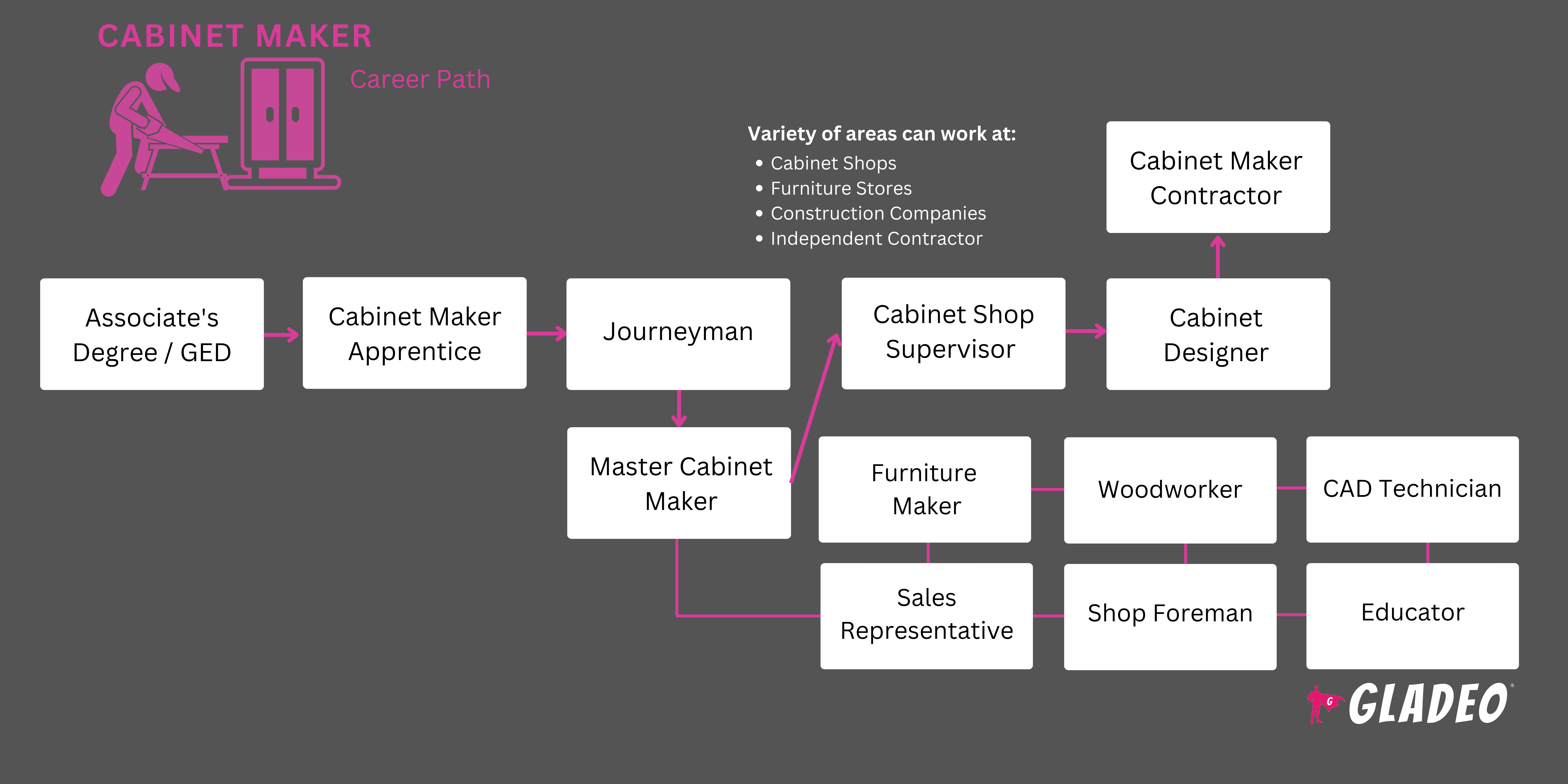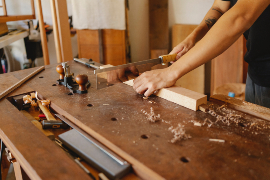Mga spotlight
Cabinet Assembler, Cabinet Builder, Cabinet Installer, Cabinet Maker, Double End Tenon Operator, Frame Builder, Framer, Woodworker
The art of cabinetmaking traces its roots back to the late Renaissance period when skilled artisans crafted beautifully intricate pieces for royalty. Today’s Cabinet Makers bring that legacy into modern times, designing, crafting, and assembling custom-made cabinets, furniture, and other elaborate wooden structures.
They possess a deep understanding of wood types and use state-of-the-art tools and programs that allow them to work with precision as they make functional, durable, aesthetically pleasing pieces. These range from kitchen and bathroom cabinets to bedroom wardrobes that reflect the individual styles of the maker. And now their work isn’t reserved only for royalty!
Some specialize in a particular niche, such as antique furniture, musical instruments, or chairs and couches.
- Job satisfaction from bringing ideas to life, from sketches to finished products
- Job security because their work is always in demand!
- Diverse opportunities, from design and restoration to construction projects
Oras ng trabaho
- Cabinet Makers work full-time with most work done indoors. They must often travel to job sites in their local area or to stores to purchase lumber and supplies.
Mga Karaniwang Tungkulin
- Design custom cabinetry and furniture based on client specifications
- Review project specifications with designers, clients, or architects
- Examine technical drawings or blueprints and plan the schedule of work
- Estimate budgets, including labor and supplies
- Verify the dimensions of where a piece is going to go, to ensure it will fit
- Operate computer-aided drafting (CAD) software to produce plans and models
- Inspect equipment or tools for proper functioning; perform routine maintenance and repairs, as needed
- Select and order lumber and materials needed to complete work assignments
- Measure, mark, and cut lumber stock to specifications
- Operate tools such as power saws and other machines
- Trim, sand, or scrape surfaces or joints to prepare pieces for finishing
- Attach parts or subassemblies to form completed units using glue, dowels, nails, screws, or clamps
- Apply finishes (such as paint, stain, or varnish) to completed products using brushes, sprayers, or rollers
- Install hardware (such as hinges, handles, catches, or drawer pulls) using hand tools
Karagdagang Pananagutan
- Maintain work records; keep track of inventory and customer orders
- Repair or alter wooden furniture, cabinetry, fixtures, paneling, or other pieces
- Practice good safety when using tools and machines
- Stay up-to-date on techniques, tools, and programs
Soft Skills
- Katumpakan
- Analitikal
- Business acumen (for self-employed workers)
- Serbisyo sa customer
- Detalyadong-oriented
- Excellent hand-eye coordination
- Manu-manong kagalingan ng kamay
- No severe dust allergies or breathing issues
- pasensya
- Pagtitiyaga
- Pagtugon sa suliranin
- Pamamahala ng proyekto
- Pagtitiyak ng kalidad
- Kaligtasan-isip
- Tamang paghatol at pangangatwiran
- Malakas na kasanayan sa komunikasyon
Teknikal na kasanayan
- Assembly techniques
- Basic math calculations
- Pagbabasa ng blueprint
- CNC machine operation (for modern workshops)
- Drafting and design, including computer-aided design (CAD)
- Edge banding
- Pagtatantya ng mga materyales at gastos
- Installation and fitting techniques; installation of hardware (e.g., hinges, handles)
- Joinery techniques (e.g., dovetail, mortise and tenon, biscuit)
- Kaalaman sa aplikasyon ng malagkit
- Knowledge of drawer slide installation and adjustments
- Knowledge of modern materials (e.g., melamine, MDF)
- Laminating
- Layout and marking techniques
- Proper use of hand tools (e.g., chisels, planes, saws) and power tools (e.g., table saw, band saw, router)
- Safety procedures
- Sanding and finishing techniques
- Sharpening tools
- Pag-unawa sa paggalaw ng kahoy dahil sa mga pagbabago sa kahalumigmigan
- Use of clamping devices and jigs
- Veneering
- Wood bending techniques
- Wood selection and identification
- Woodturning (for custom pieces)
- Sa sarili nagtatrabaho
- Cabinetmaking businesses
- Homebuilding companies
- Retail outlets
- Mga museo
- Theater/film production companies
- Institusyong pang-edukasyon
- Design studios
Cabinet makers are expected to merge both artistic flair and technical prowess. They must craft pieces that are functional and aesthetically appealing, which requires a keen eye for design—plus a mastery of woodworking techniques!
While making a name for themselves, they might have to invest in tools and materials, if they are self-employed. Cabinet makers often face long workshop hours, risking physical strain and potential injury. The time commitment becomes even greater as trends and technology shift, requiring them to keep up with the changes.
In recent years, minimalism has dominated cabinetmaking, with clean lines and unadorned facades becoming a staple in modern homes. The push for simplicity has seen a preference for handleless cabinets and neutral color palettes.
Sustainability is another emerging trend. Cabinet makers are increasingly sourcing eco-friendly materials, emphasizing reclaimed woods and low-VOC finishes. This shift not only caters to environmentally-conscious consumers but also promotes longevity and durability in cabinetry.
Lastly, technology integration is reshaping traditional cabinet designs. Features like built-in USB ports, touch-to-open mechanisms, and under-cabinet lighting showcase how modern cabinets are evolving to meet the tech-savvy demands of contemporary living spaces.
Many cabinet makers, in their younger years, showed an affinity for hands-on activities. They might have enjoyed hobbies such as woodworking, crafting, or building models. Engaging with tactile experiences like whittling, assembling toy sets, or repairing household items likely ignited their passion for creation, serving as a foundation for their journey into cabinetmaking!
- Cabinet makers need a high school diploma or equivalent
- Vocational, technical school, or even high school courses in woodworking or cabinetry are a solid way to get started!
- A college degree isn’t necessary, though 19% do earn an associate’s and 22% hold a bachelor’s, per Zippia. However, they may complete these later in their careers, versus at the start
- Cabinet makers learn many if not most of their skills through apprenticeships, learning from a seasoned professional. They start with small tasks and work their way up over a period of about 3-4 years
- An apprenticeship may require 2,000 hours of combined on-the-job training plus formal classroom instruction per year (thus a 4-year apprenticeship would involve ~8,000 hours of OJT and classroom instruction)
- Per the Carpenters Training Institute, a typical apprenticeship program might look like this:
- The first year will cover a lot of safety issues, including first aid, CPR, and machine safety, as well as an introduction to using table saws
- The second year covers more table saw use, as well as machine woodworking, solid surfaces, etc.
- The third year covers European cabinetry, laminating, exhibit construction, interior trim, and CNC routers while continuing with machine woodworking and solid surfaces
- The fourth year covers custom toolboxes, ICRA “Health Care Construction,” and other topics
- Note, the above are just sample topics from one training institute!
- Cabinet makers can also apply for certifications from the Woodwork Career Alliance of North America or Cabinet Makers Association or enter training programs like the Architectural Woodwork Institute
- Isaalang-alang ang halaga ng matrikula, mga diskwento, at mga pagkakataon sa lokal na iskolarship (bilang karagdagan sa tulong na pederal)
- Think about your schedule and flexibility when deciding whether to enroll in an on-campus, online, or hybrid program. Ideally, you’ll want as much hands-on practice as you can get for many of these cabinetry courses
- Look closely at the program’s facilities and equipment
- Check out the program’s faculty awards and accomplishments
- Try to read reviews from previous students
- Suriin ang mga istatistika ng paglalagay ng trabaho at mga detalye tungkol sa alumni network ng programa
- Cabinet Makers should prepare for their apprenticeships by taking English, art/design, general math (arithmetic, fractions, decimals, ratios, proportions), geometry, chemistry, physics, drafting, computer-aided design, and woodworking or shop courses
- Gain hands-on skills under the supervision of a professional who can show you how to work safely and use tools properly
- Do well in school, because apprenticeship programs can be very competitive
- Often high school students can take community college or vocational training classes simultaneously. Ask your school counselor for assistance
- Expand your practical knowledge through online classes
- Get practical work experience through part-time carpentry or construction jobs
- Consider volunteering on local Habitat for Humanity projects
- Watch related videos on YouTube channels like MWA Woodworks and Bourbon Moth Woodworking
- Educate yourself through cabinetry books, magazines, and online articles
- Ask a working Cabinet Maker if they have time to do an informational interview with you
- Decide what type of cabinetry work you might want to specialize in such as antique furniture restoration, cabinets, chairs and couches, etc.
Note, many employers in the skilled trades, including cabinet making, conduct drug tests as a part of their hiring process to ensure a safe working environment. The use of heavy machinery and tools can be hazardous, so employers (and insurance companies) have to reduce risks. If the apprenticeship is through a union, keep in mind that some unions mandate pre-apprenticeship drug tests or random drug tests throughout the apprenticeship.

- Rack up as much relevant experience as you can in school and through volunteer work before applying for an apprenticeship
- Job portals like Glassdoor, Indeed, USAJOBS, or SimplyHired are often the best starting points for finding jobs
- Look for apprenticeship opportunities at Apprenticeship.gov
- Ask your school’s career services staff for help with resumes, mock interviews, and job searches. They may have direct connections to local unions that offer apprenticeships!
- If applying for a union apprenticeship, read the application instructions carefully before filling anything out
- Don’t just type responses to questions directly into a website. Write them in a separate document, so you can spell-check them more easily and also save them for use elsewhere!
- There may be basic exams to test your knowledge, however, “most unions don’t expect you to be an expert in your industry at this point,” notes Indeed
- You can take practice exams to find areas where you might need to study more
- If your application is accepted, there will generally be an apprenticeship interview, so plan ahead by reading potential questions and preparing your answers
- Reach out to your network to let them know you are looking for work
- I-screen nang mabuti ang mga ad ng trabaho para matiyak na natutugunan mo ang mga kinakailangan at may tamang karanasan
- Look for important keywords to work into your resume/application
- Ituon ang iyong resume sa mga nauugnay na karanasan at kasanayan sa trabaho at akademiko, at subukang i-quantify ang data kapag kaya mo
- Makisali sa mga online na forum at magtanong ng mga tanong sa payo sa karera
- Tanungin ang iyong mga propesor, superbisor, at mga kapantay kung magsisilbi sila bilang mga personal na sanggunian
- Review Cabinet Maker resume templates to get ideas for formatting and phrasing
- Maghanap ng mga karaniwang tanong sa pakikipanayam upang maghanda para sa mga mahahalagang panayam
- Palaging magsuot ng angkop para sa tagumpay sa pakikipanayam sa trabaho!
- Panatilihing propesyonal ang iyong presensya sa social media, dahil hinahanap ka ng mga employer online
- Cabinet Makers start as apprentices and work their way up to journeyperson and master levels over the course of years
- Talk to your supervisor and trainer about how you can progress faster. Let them know you are willing to knock out any professional development training your employer suggests
- Complete advanced certifications when you have the minimum experience needed
- Cabinet makers can apply for certifications from the Woodwork Career Alliance of North America or Cabinet Makers Association
- Consider pursuing a relevant degree or courses in specialized areas of cabinetry, design, manufacturing, or engineering
- Stay up-to-date on drafting software and machine technologies
- Keep active in professional organizations to learn new things and grow your network
- Challenge yourself to work on more complex projects
- Continue to learn about aesthetics and structural principles related to making unique, sought-after pieces
- If necessary, apply for jobs that offer more advancement potential—or launch your own business
Mga website
- Acadia Craft
- Apprenticeship.gov
- Arbor Mills
- Architectural Woodwork Institute
- Asosasyon para sa Teknolohiya sa Paggawa
- Authentic Custom Cabinetry
- Bakes and Kropp
- Beech Tree Woodworks
- Benvenuti and Stein
- Brooklyn Millwork
- Tagagawa ng kabinet
- Cabinet Makers Association
- Cabinet Solutions
- Institusyon ng Pagsasanay ng mga Karpintero
- Excel Cabinets
- Fabricators & Manufacturers Association
- J.T. Dreyer
- McMillan Cabinetmakers
- Merit Kitchens
- Millcreek Cabinet
- National Tooling and Machining Association
- Rainier Cabinetry
- Structures Cabinet and Design
- T2 Cabinets
- Tri-Tex Cabinets
- Vogue Furniture
- Wheatland Cabinets
- Wood Industry Resource Collaborative
- Woodwork Career Alliance of North America
- Woodworking Machinery Industry Association
Mga libro
- From Sawdust To Sales: How to Market and Manage Your Cabinetry Business, by Jason M Dorr
- How To Make Kitchen Cabinets: A Comprehensive Guide To Building Custom Cabinetry, by Pascal Arthur
- The Artisan Furnituremaker: A Creative Survival Guide, by Darrell Peart
- Woodworking Furniture Mastery, by Peter Williams
The skill and artistry of Cabinet Makers remain in high demand, but the Bureau of Labor Statistics projects a slight decrease in the number of workers that will be needed for this field in the future. This is due, in part, to automation, with computer numerically controlled (CNC) machines being increasingly used in wood product manufacturing. As a result, apprenticeship opportunities may become even more competitive.
For those who might be interested in related occupations, here’s a short list of alternatives to consider!
- karpintero
- Inspektor ng Konstruksyon at Gusali
- Manggagawa sa Konstruksyon
- Drywall Installer
- Flooring Installer and Tile and Stone Setter
- Furniture Finisher
- Pangkalahatang Maintenance at Repair Worker
- Insulation Worker
- Model Maker
- Roofer
- Solar Photovoltaic Installer
- Structural Metal Fabricator at Fitter
- Woodworking Machine Setter, Operator, at Tender
Newsfeed

Mga Tampok na Trabaho

Mga Online na Kurso at Tool







